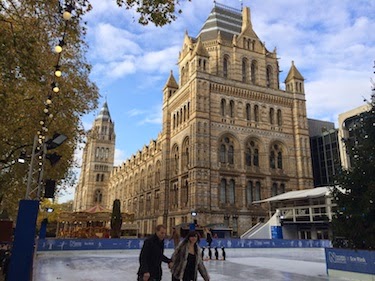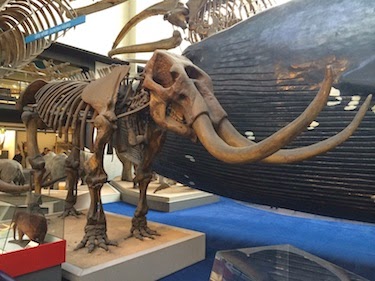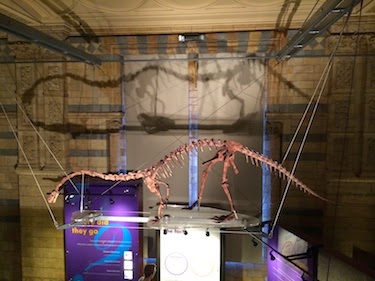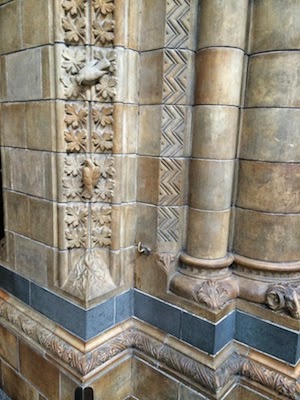 |
| London’s Natural History Museum (and Ice Skating Rink) |
I confess I wasn’t particularly looking forward to visiting the Natural History Museum in London. While I love the natural sciences and dinosaurs in particular (like any male), I’ve seen plenty of stuffed, extinct animal displays in my day (even on this trip). I guess I’ve sadly developed a seen-one-seen-them-all sort of attitude.
Fortunately, there’s plenty enough variety and uniqueness at the massive Natural History Museum in London to engage even the most jaded visitor for a few hours. And besides: like all public museums in Britain, admission is free (like I’ve said, I’m frugal, not cheap). I knew London’s Natural History Museum was going to be a pleasant surprise when I marveled over the full-sized cross section of a petrified tree trunk in the main entrance hall. That’s right: I was enamored with an old piece of wood. But, you see, it was big–at four feet high and three feet in diameter, it was the largest chunk of petrified wood I’ve ever seen–and remarkably complete. You could still see the rings. And you could actually touch it (I’m not actually sure I was supposed to be touching it, but there were no signs to the contrary and other visitors were inspecting it in a tactile manner). Did I mention that it was really, really old?
The museum is huge and houses plenty of complete dinosaur skeleton displays and those kitschy stuffed animals, but what was so great about the way they were displayed was how close you could get to them to inspect them. Many were in glass boxes, but the enclosures were just large enough to house the specimen so that you could get in close for a good, steamed-glass look. Many of the stuffed animals–the rhinos, hippos, elephants, and wooly mammoths in particular–were positioned so you could smell them if you wanted. Which, of course, I did. Musty leather, in case you’re wondering.
Interestingly, many of the specimens were collected during the Victorian age when practically any man of means and interest called themselves a naturalist and set out to some far corner of the globe to collect specimens. In those days, the world was not prepared for the onslaught of English naturalists and few laws and standards existed to govern the collection of species. As such, many of the displays are unique and the only ones in the world ever collected before common sense imposed strictures on collecting them. We saw one sign explaining this and pointing out that this was why, for many of the animals displayed, the fur was now so dingy and faded.
 |
| Lori Admiring a Diplodocus Skeleton |
 |
| A Wooly Mammoth Skeleton |
In the dinosaur hall, you climb stairs and pass over most of the display before dismounting the raised level and returning back through the floor-level display. It’s a fantastic setup, as on the way you are treated to a number of dinosaur skeletons suspended from the ceiling and interestingly-illuminated. The displays not only give the name of the specimen and a few tidbits of details, but they all include an outline comparing the size of the prehistorical animal to a man, giving you a good idea of how large the animal is believed to have been.
The Natural History Museum has been called a temple to natural science. That’s for good reason. The museum’s grand Romanesque building was designed by Francis Fowke and Alfred Waterhouse, and construction was completed in 1880. Inside and out, the building is covered with terra cotta tiles that are decorated with fossils, plants, and other decorations that remind you this building is still doing, 130 years later, what it was intended to do: show off the wonders of the natural world. It’s an impressive museum, even if many of the exhibits are stuffed and wired together.
 |
| Massospondylus Skeleton |
 |
| Architectural Details |
 |
| Charles Darwin |
Interesting, little-known fact: Charles Darwin is credited with the theory of natural selection, but it was nearly simultaneously discovered by naturalist Alfred Russel Wallace. Both men, by the way, were some of those Victorian English naturalists that traveled to the far corners of the globe driven by their curiosity.






